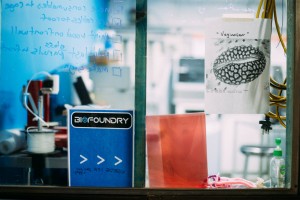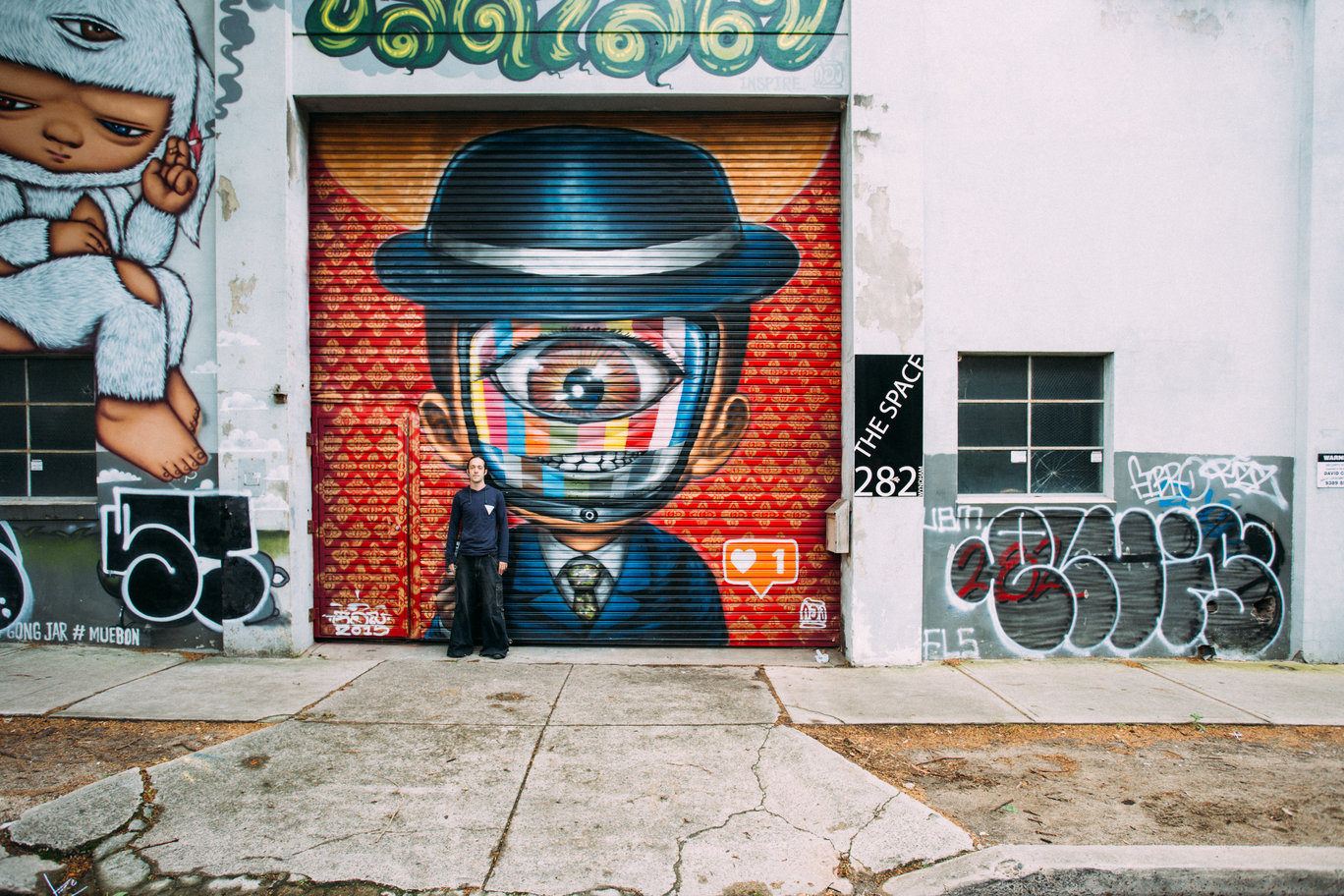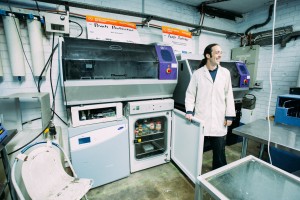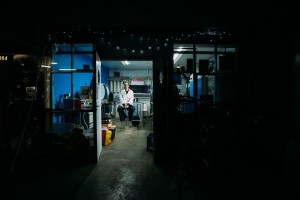Meow-Ludo Meow-Meow arrives in an old, blue car with a wide smile and a wave. The 31-year-old founder of the first biohacking lab in Australia is dressed in a plain t-shirt and jeans and has a long dark ponytail. Meow, who changed his name by deed poll, has an upbeat way of talking about […]
Meow-Ludo Meow-Meow arrives in an old, blue car with a wide smile and a wave. The 31-year-old founder of the first biohacking lab in Australia is dressed in a plain t-shirt and jeans and has a long dark ponytail.
Meow, who changed his name by deed poll, has an upbeat way of talking about the future.
When asked about the biohacking movement, he outlines the core philosophy as he sees it – a playful and tinkering approach to science, set in contrast to the results-driven attitudes of traditional labs.
With curiosity and creativity at the forefront, the hope is that “following interesting tangents will lead to innovations that couldn’t happen in a traditional university laboratory”, Meow explains.
The molecular biologist often intertwines social and political commentary throughout explanations of how and why they are engaging in this counter-culture approach to science, and it’s clear that beyond the creation of cool technology, there’s a revolutionary element at play – they want the public to get their collective hands dirty with science.
Australia is in the throes of the launch of its first two community labs for citizen scientists. Meow’s BioFoundry is based out of Alexandria in central Sydney and BioQuisitive is located in Brunswick in the inner north of Melbourne. These two community-run spaces set out to democratise science by breaking down the cost of entry to science education and research.
Biohacking is the latest iteration of the so-called maker movement, which is one of the more encouraging extensions of the digital age.
The maker movement emphasises learning-through-doing (constructivism) in a social environment. It encourages informal, networked, peer-led, and shared learning motivated by fun and self-fulfilment. It encourages novel applications of technologies, and the exploration of intersections between traditionally separate domains and ways of working including metal-working, calligraphy, film making, and computer programming.
Community interaction and knowledge sharing are often mediated through networked technologies, with websites and social media tools forming the basis of knowledge repositories and a central channel for information sharing and exchange of ideas, and focused through social meetings in shared spaces such as hackspaces.
Maker culture has attracted the interest of educators concerned about students’ disengagement from STEM subjects (science, technology, engineering and mathematics) in formal educational settings. Maker culture is seen as having the potential to contribute to a more participatory approach and create new pathways into topics that will make them more alive and relevant to learners.
Some believe the maker movement is a reaction to the devaluing of physical exploration and the growing sense of disconnection with the physical world in modern cities. Other scholars including Raymond Malewitz and Charles Jencks have examined the utopian vision of maker culture, which they link to myths of rugged individualism, the possibility of a counter-culture and libertarianism. Many products produced by the maker communities have a focus on health (food), sustainable development, environmentalism, local culture and can from that point of view also be seen as an anti-response on disposables, globalised mass production, the power of chain stores, multinationals and consumerism.
In reaction to the rise of maker culture, US president Barack Obama pledged to open several national research and development facilities.
The maker movement is a social movement with an artisan spirit in which the methods of digital fabrication – previously the exclusive domain of institutions – have become accessible at a personal scale, following a logical and economic progression similar to the transition from minicomputers to personal computers in the microcomputer revolution of the 1970s. In 2005, Dale Dougherty launched Make magazine to serve the growing community, followed by the 2006 launch of Maker Faire. The term, coined by Dougherty, grew into a full-fledged industry based on the growing number of DIYers who want to build something rather than buy it.
Spurred primarily by the advent of 3D printing for the fabrication of prototypes, declining cost and broad adoption have opened up new realms of innovation. As it has become cost effective to make just one item, this approach can be depicted as personal fabrication for “a market of one person”.
In the case of biohacking, Meow describes the overarching ethos as a “democratisation of science”, that would see lower technological and cost barriers to studying science.
“The part I feel most strongly about is civic science,” he says. “This is about people having respect and understanding science because they practice it in their daily life.”
In part, they do this around their lab in the semi-industrial suburb of Alexandria. Undergoing rapid gentrification, Alexandria now boasts artisan patisseries, cafes and boutique shops among the warehouses and remnants of heavy industry. For Meow and his colleagues, it represents an opportunity to get involved with the local businesses by helping out with such things as the construction of hydroponic systems or modifying yeasts.
Low-cost labs could also have significant impacts in rural and remote towns, and in developing countries where the limitations are similar.
“Personally I would love to see a biohack lab in every community. It would be a place where you are moving away from authoritarianism and moving away from centralisation.
“We want to have networks of independent labs that share resources, both education resources and lab equipment that put science back in the hands of the ordinary person.”
But it gets even wilder than just citizen biology labs for the purposes of education.
Modifying plants to make them glow, changing cells on a genetic level, using “nootropic” supplements to make you smarter and even inserting magnets into your fingertips are all pursuits that fall under the banner of biohacking.
It’s a transhumanist’s dream, and an anti-technologist’s nightmare.
Biohacking HQ
Meow ducks under the half-opened garage door and into the 1500-square metre warehouse that is home to BioFoundry and an assortment of other artists and creators.
To the right are three industrial designers chattering around a long work table, and behind them are pots each filled with bundles of long fluorescent sticks. They’re working on an art commission for a Saudi Arabian prince, Meow thinks.
There is a mechanic’s station and to the left and an enormous white Cadillac gleaming in the shadows. With everything else going on you could almost have overlooked the perfectly coiffed woman with goth make-up, bright green lipstick and jet black hair and a tight corset. She’s sitting on a pile of tyres, in the middle of a photoshoot.
Meow peels off into the BioFoundry lab and starts explaining the equipment. An Occulus Rift virtual reality system sits in a box under one of the silver benches.
“The thing you’ll find most different here [from commercial labs] is that there’s no-one that’s explicitly in charge. We have safety officers, but we encourage peer-learning,” he says.
Also unlike a university lab, there are different groups co-working together in the space, giving people the opportunity to think about things from different perspectives, he says.
“So in this space you’ll have people working on electronics, 3D printing, someone’s working on diagnostics, someone’s working on Activa [the yogurt]. Then you combine all these things in the same space, and when you’re teaching each other about these different things, it opens up new avenues of thought.”
While hacking can have a certain illegal or immoral connotation, the hacker ethic is one of transparency, sharing, community improvement and decentralisation.
Their interdisciplinary approach combines the skills of biologists, engineers and any other enthusiastic member of the public with a hacker philosophy.
For example, one individual considering starting up a biohacking space in Brisbane specialises in virtual reality, rather than biology. Meow says that questions like, “How do science and art fit together? How do science and motorbikes fit together?” are asked all the time there.
Virtual reality could be a powerful tool in molecular biology education for instance. Being able to visualise shapes on a molecular or atomic level can help people to understand what is actually happening on that level, rather than only seeing the reactions that they result in.
Perhaps the most impressive example to emerge in Australia recently is Dr Steven Lee’s droplet lens.
The University of Canberra-based optical scientist developed an inexpensive lens that can turn any mobile phone camera into a microscope. Dr Lee’s invention saw him take out ANSTO’s Eureka Prize for Innovative Use of Technology.
His droplet lens uses the surface tension of liquids and gravity to easily and affordably manufacture a tiny lens that fits over a smartphone camera and turns it into a microscope. Currently, the lenses can be churned out for $2 a piece.
Amazingly, Lee’s microscopes can be made at home on a 3D printer. If Lee’s invention can be made widely available, the ramifications for everything from medical diagnosis through to farming are obvious and profound.
At a more extreme level, people are working on insulin pump implants that record blood glucose levels and crack the capsule to insert its contents into the blood stream when it gets too low. Such devices could even one day sync up to a smartphone and call an Uber or ambulance if it looks like the user is going to have a hypoglycemic episode.
Limitless?
Alongside a growing awareness of mental illness and the development of therapies and drugs to change our brains, we are seeing a parallel emergence of those trying to improve, not just to baseline but to expand beyond their current limitations. Neutraceuticals and nootropics are supplements are claimed to improve memory, concentration, alertness and more. Recently modafinil, an anti-epileptic, has gained in popularity as a nootropic.
Australian futurist and chairman of the Future Exploration Network, Ross Dawson, thinks of biohacking as one specific manifestation of what is now incredible power available on an individual level.
“We now have the ability to do things in just about every domain of technology that would’ve required massive institutions to do a decade or two ago,” Ross says.
“In the field of genomics there is a faster acceleration [of development] than processing power or any other information technology, it is so many orders of magnitude cheaper to be able to sequence genetic data and [there are] more and more tools to be able to edit genes.
“Critically we are moving into a world where there are two types of people: those that want to augment themselves and those who choose not to. This is the vanguard, and we will all soon have many more commercial ways to be able to augment our capabilities, rather than to simply cure diseases.
“With developments in gene technology, people are looking at ways to knock out particular genes that will reduce susceptibility to colds or diseases, he says. “And if this is something we feel we can do to ourselves, either by experiment with ourselves, or to sort of follow a 1-2-3 guide, then people will be doing it.”
Out of the shadows
The threat of constant surveillance by government and companies is a growing concern for many in the wake of Australia’s new meta-data laws and Google’s and Facebook’s ever-more sophisticated algorithms for collecting data.
But for Meow, transparency is beyond a necessary evil. It is core to the philosophy of biohacking and the democratisation of science.
It also helps to allay fears that they are up to anything nefarious, either from the government or the general public.
One commonly raised concern over labs like this are that they could enable people with the will and inclination for it to engage in bioterrorism.
“The fear is unfounded, because you don’t need a space like this to do that type of stuff, and a space like this actively discourages it,” Meow says.
Anything they are capable of in their labs could be replicated in someone’s garage. A first year student could grab a cup of dirt and isolate anthrax or go to a pond and find the material necessary to make Botox, he argues.
Instead, this community space that represents transparency and improvement for humanity is much more likely to create a sense of belonging that would work against radicalisation, he says.
“I think people are terrified of the unknown, and molecular biology is a huge unknown.
“Molecular biology is really fucking exciting at the moment and needs to be encouraged.”
Bring me your poor
To be part of BioFoundry, membership sets you back $60 per month. Those who want to use the space but maintain intellectual property and secrecy around their work are looking more at $100-$150 per month though.
This is substantially cheaper than even other cheap labs, which are more in the realm of $100-$150 per square metre – or $3000-$4000 per month.
With the lower price, they are perfect for university students heading towards the end of their degree who need to come in, get something together and then get seed funding.
“Also, no-one is turned away due to lack of funds,” Meow says, citing social media, cleaning the lab or glassware, taking inventory or doing organising as tasks that can count towards lab time.
“If it’s inaccessible to the poor, it’s neither radical nor revolutionary,” he quotes.
The $5000 it cost to start the lab pales in comparison to the $200,000 to $300,000 it costs for commercial labs.
BioFoundry is a not-for-profit educational charity, but is still finalising the space to bring it up to the gene technology regulator’s standards before officially opening to the broader public.
While Meow works there full-time, in between teaching some molecular biology classes at local universities, the lab really needs full-time staff to run properly, he says.
So much equipment is thrown out by professional labs in Australia, Meow explains.
It’s through this waste, and donations by members and people interested in the project, that they are able to start a lab at such a cheap price.
“Rent is our most expensive factor,” he says.
BioFoundry routinely asks drug labs and universities if any equipment is being thrown out, and even wait at dumpsters when they know an order for new equipment is coming or a lab is being renovated.
“This is especially for glassware. The universities have to smash it to prevent drug manufacturers from taking it,” he says.
Being able to develop low-cost equipment is important, not just for innovation here but also for the benefit of the developing world, they argue.
“The problems we have in this lab are the same ones that doctors have in the Third World,” says Meow. “Trying to make an incubator for $10 is something we face every day. And if we create a solution that can be communicated to doctors over there.”

It’s not all about health
Biohacking also incorporates body modification, or grinding as it’s know, as well as bioart, a huge field in Australia.
A recent conference in Perth highlighted one example of this, with an artist named Guy Ben-Ari who had created a musical instrument out of his own skin. The artist had flown to labs across the country and the world to obtain the tools to create the project, in which he took his own skin cells, turned them into stem cells, then turned them into neurons. He then laid those down on an electrical frame, and converted it into a musical synthesiser. As neurons do, they are growing in response to musical stimulus, and are developing independently as time goes on.
Australian-based artist Stelarc has brought prominence to the movement by exploring the notion of the human body’s obsolescence.
His performance art delves into the interconnectedness of technology and the body, and for the past nine years he has been growing a third ear in his arm with the hopes of connecting it to the internet for people to listen to.
Without going that far, other grinders have been surgically inserting magnets into their bodies, constructing a mild superpower that they claim enables them to feel magnetic fields and live currents.
While he is considering implanting a chip that would allow him to open his house and lab door with just a swipe, Meow says that grinding isn’t really his thing. “It’s just not cool enough yet.”




